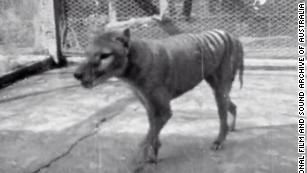The project involves several complicated steps that incorporate cutting-edge science and technology, such as gene editing and building artificial wombs.
First, the team will construct a detailed genome of the extinct animal and compare it with that of its closest living relative — a mouse-size carnivorous marsupial called the fat-tailed dunnart — to identify the differences.
“We then take living cells from our dunnart and edit their DNA every place where it differs from the thylacine. We are essentially engineering our dunnart cell to become a Tasmanian tiger cell,” Pask explained.
Once the team has successfully programmed a cell, Pask said stem cell and reproductive techniques involving dunnarts as surrogates would “turn that cell back into a living animal.”

‘Precious’ footage from 1935 of last-known Tasmanian tiger released
“Our ultimate goal with this technology is to restore these species to the wild, where they played absolutely essential roles in the ecosystem. So our ultimate hope is that you would be seeing them in the Tasmanian bushland again one day,” he said. The fat-tailed dunnart is much smaller than an adult Tasmanian tiger, but Pask said that all marsupials give birth to tiny young, sometimes as small as a grain of rice. This means that even a mouse-size marsupial could serve as a surrogate mother for a much larger adult animal like the thylacine, at least in the early stages.
Reintroducing the thylacine to its former habit would have to be done very cautiously, Pask added.

I love this kind of stuff. Next, hopefully, they can get some Tyrannosaurus Rex DNA and combine it with a Komodo Dragon. Then, we can forget all this global warming/climate change stuff. This is better that rebuilding the Beaver population. The temperature and sea rise will perfectly facilitate the creation of the conditions that benefitted the dinosaurs. All my eight year old fantasies of dinosaurs stomping around can be realized. Please, I’m serious. I want to see a Sabretooth Tiger, before I see no more…
What’s the worst that could happen? Asked no one apparently.
If we don’t know where we’ve been, how do we know where we’re going?
Maybe some one could make a movie about restoring the dinosaurs. Betcha it would be a hit!
I’m sure there won’t be any problems with genetic engineering things, unlike viral research….
Fred
nothing ventured, nothing gained 🙂
borko,
Pandora thought the same thing.
Fred
we live in a time where supposedly educated and civilized people are shelling nuclear power plants.
Compared to that, a bit of genetic engineering is small potatoes.
“Compared to that, a bit of genetic engineering is small potatoes.”
NO, absolutely not, though idiotic and immediately dangerous shelling nuclear power plants is NOT complex, we have “experience” of possible consequences with Tchernobyl and Fukushima.
Whereas, despite tinkering already with mRNA, CRISPR and “gain of function” we have ZERO practical understanding of morphogenesis, embryogenesis and correspondance between genotype/phenotype.
How did the humongous number of parasitic organisms came to be?
https://carlzimmer.com/books/parasite-rex/
Borko,
Of course it’s “russians”, who waited months before doing all of said self inflicted shooting. Ukrainians have switchblades etc to take out stuff like that. As to risk, I recommend “White Helments”.
jld
well how are we going to get experience and practical knowledge if we dont try things out?
They will make great pets….
The last one we know of died in captivity in the 1930’s. I say “ we know of” because there is still talk of sightings in Tasmania.
walrus
I was in South Island, NZ some years ago tramping, as the Kiwis call it, and one utterly still day on top of a mountain ridge was certain I heard a Kakapo calling. I’d seen a documentary on them and thought I recognized the low booming call from that. This was in an area where they were supposed to have been extinct for a long time and hadn’t be reintroduced. I reported it to the DOC but they weren’t interested and probably thought I was nuts. I guess it’s possible it was something else but Heaven knows what if so. Also witnessed a seiche on that trip (the day before). Truly a memorable visit.
If these things show up again, they’d better stay off my lawn.
Excellent Australian movie, ” The Hunter,” starring Willem Dafoe who went looking and found one of these on Tasmania.